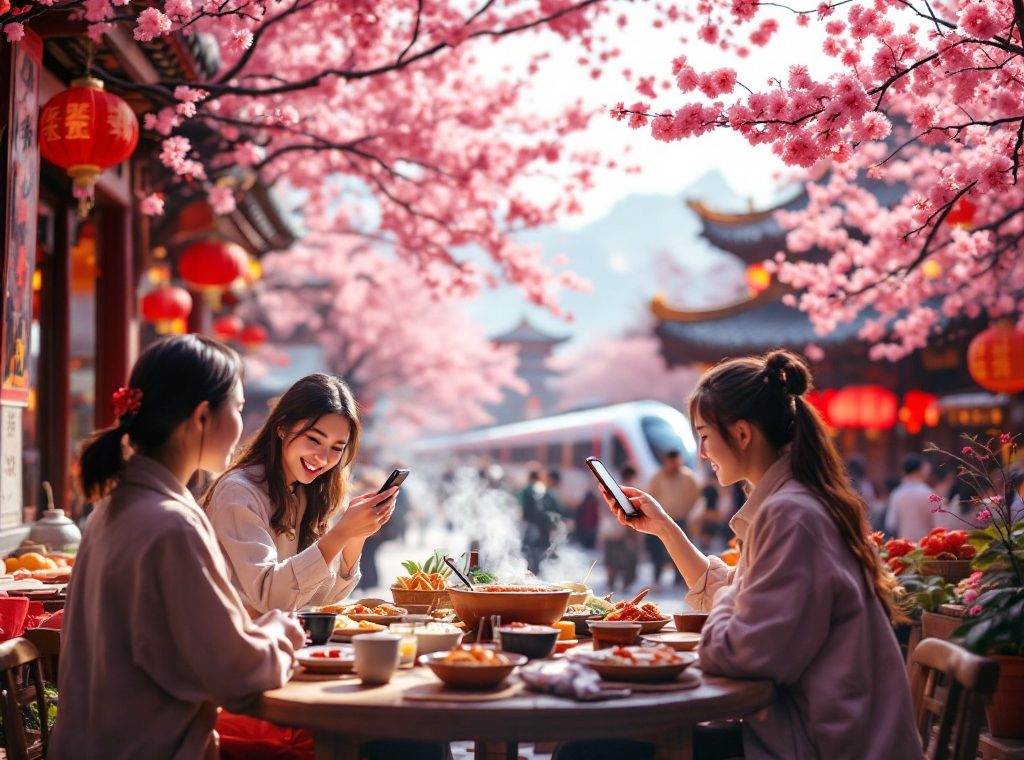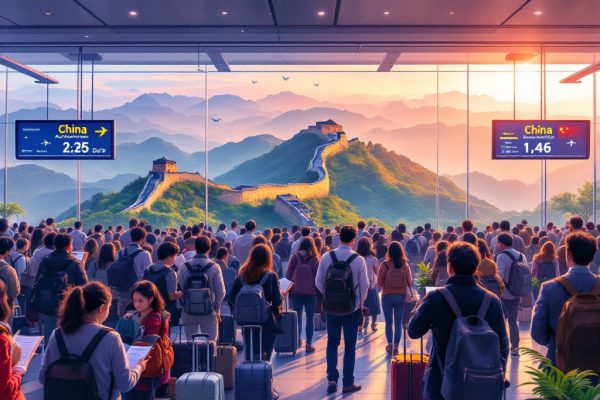Local Travel Tips for China: An Authentic Experience
Dream of exploring China authentically? Discover the best times to visit, from vibrant spring blossoms to crisp autumn air, avoiding peak crowds and inflated prices. Learn how to navigate China’s world-class public transport, from high-speed rail to convenient ride-hailing apps, and embrace a cashless society. Master basic Mandarin, understand cultural etiquette, and savor regional delicacies like Peking duck and Sichuan hot pot. Uncover the secrets to a truly immersive experience, from local markets to respectful interactions, and prepare for an unforgettable journey through the heart of China. Dive in and start planning your adventure!
Important information

- For authentic travel, explore beyond tourist hotspots, use public transport, engage with locals, and learn basic Mandarin.
- Visit during spring (April-May) or autumn (September-October) for pleasant weather and fewer crowds, avoiding peak seasons like Chinese New Year and National Day.
- China offers a vast and efficient public transportation system, including high-speed trains between cities and affordable metros and buses within cities. Mobile payment apps are widely used.
- Be prepared for cultural differences. Learn basic customs, like bowing instead of shaking hands, and be mindful of dining etiquette. Download a translation app and carry some cash.
- China’s diverse cuisine offers regional specialties. Explore local markets and restaurants. Be sure to try Peking duck, dim sum, hot pot, and dumplings. Use bottled water.
Planning Your Authentic Travel Experience in China
Experience the true essence of China by exploring beyond the usual tourist hotspots and engaging with local communities. Consider staying in homestays or guesthouses nestled within historic neighborhoods for an authentic cultural immersion. Utilize public transport such as buses and trains to interact with locals and observe daily life.Learning basic Mandarin phrases is a great way to show respect and enhance communication with locals. Explore vibrant local markets, savor delicious street food, and participate in local festivals to experience authentic Chinese culture. Skip the crowded tourist traps and discover the diverse cultures China has to offer. While a knowledgeable guide can be valuable, independent exploration can lead to unexpected discoveries and boost your confidence in navigating new environments.
Embrace Local Experiences
- Stay in homestays or guesthouses in historic neighborhoods.
- Use public transport like buses and trains.
- Learn basic Mandarin phrases.
Explore Authentic China
- Explore local markets and enjoy street food.
- Participate in local festivals.
- Venture beyond tourist traps.
Visa for China: What You Need to Know
Planning a trip to China? Here’s a quick guide to visa requirements:
Visa Requirements
Most nationalities require a visa to enter China, usually a tourist (L-visa) obtained before your trip. This involves submitting a detailed itinerary and accommodation plan.
Visa-Free Options
- 72 or 144-hour Transit: Depending on your nationality and the specific Chinese city, you might be eligible for 72 or 144-hour visa-free transit.
- 30-Day Visa-Free Entry: A 30-day visa-free entry program is available for eligible nationalities from November 30, 2024, to December 31, 2025.
Passport Validity: Ensure your passport has at least six months of validity and two blank pages.
Choosing the Best Travel Seasons: Spring and Autumn
Planning a trip to China? Spring and autumn offer the ideal blend of pleasant weather and manageable crowds. Visit in spring (April-May) to witness vibrant blossoms and enjoy comfortable temperatures. You’ll also encounter fewer tourists compared to the summer months. Alternatively, consider autumn (September-October) for dry, mild weather, perfect for exploring China’s diverse landscapes. Skip the busy summer and cold winter for a more enjoyable travel experience. Here’s a breakdown of why spring and autumn are the best times to visit:
Spring (April-May)
- Pleasant temperatures: enjoy comfortable weather ideal for outdoor activities.
- Vibrant blossoms: witness stunning floral displays, especially if you’re visiting gardens or parks.
- Fewer crowds: experience a more relaxed trip with less competition for attractions and accommodations.
Autumn (September-October)
- Dry and mild weather: perfect for exploring China’s diverse landscapes, from mountains to ancient cities.
- Comfortable temperatures: enjoy crisp air and sunny days suitable for hiking and sightseeing.
- Beautiful foliage: in certain regions, witness the leaves changing colors, adding a touch of magic to your trip.
Avoiding Peak Travel Times: Chinese Festivals and Holidays
Planning a trip to China? Be strategic about your travel dates. Prices skyrocket and tourist crowds swell during major festivals, especially the Spring Festival (Chinese New Year) and National Day (October 1st). Traveling during these peak seasons means battling packed trains and navigating overflowing streets. For a more enjoyable experience, consider visiting during the shoulder seasons of spring or autumn. These periods offer pleasant weather, fewer crowds, and better deals on flights and accommodations. Imagine exploring ancient temples in tranquility or strolling through bustling markets without the usual hustle and bustle. Spring and autumn offer a more relaxed and authentic China experience.
Peak Season (Avoid)
- Spring Festival (Chinese New Year): Expect massive crowds, inflated prices, and transportation challenges,
- National Day (October 1st): Another peak travel period with large crowds and increased costs.
Shoulder Seasons (Recommended)
- Spring: Pleasant weather, fewer crowds, and better deals,
- Autumn: Similar benefits to spring with comfortable temperatures and less congestion.
Navigating China’s Transportation System
China’s public transportation system is world-renowned for its efficiency and extensive reach. From high-speed rail connecting distant cities to comprehensive bus and subway networks within urban centers, the country offers diverse travel options. Major cities like Beijing and Shanghai enhance accessibility for international visitors with English signage in most metro stations.
Traveling Between Cities
High-speed trains provide a comfortable and convenient way to travel between cities. They offer a fast and efficient way to cover long distances, allowing you to explore various regions of China with ease.
Navigating Within Cities
Ride-hailing services and taxis simplify urban navigation, offering convenient door-to-door transportation within cities. In smaller towns and cities, bicycles, often accessible through bike-sharing programs, offer a practical and cost-effective alternative.
China’s largely cashless society relies heavily on mobile payment apps like Alipay and WeChat Pay. These platforms streamline transactions, including transportation payments, and often integrate directly with transportation services, allowing users to book and pay for tickets seamlessly. This makes it incredibly convenient for both locals and tourists to navigate the country’s transportation systems.
Understanding China’s World-Class Public Transportation
China’s public transportation system is truly remarkable, comprising a vast network of buses, subways, and trains. This comprehensive system proves particularly valuable in vibrant metropolises like Beijing and Shanghai. The metro is notably affordable, clean, and user-friendly, often featuring English signage, a boon for international visitors. Abundant buses and reasonably priced taxis further enhance the ease of travel. Public transport offers an immersive experience of local life. For longer journeys, the comfortable high-speed trains are an excellent choice, efficiently connecting major cities across the country. While buses and subways excel for navigating within urban areas, exploring by bus offers a unique perspective. Traveling within cities is made easy and affordable thanks to the extensive metro and bus networks. For traveling between cities, the high-speed train network offers comfort and efficiency.
Getting Around Within Cities
- metro: affordable, clean, user-friendly, often with English signage,
- buses: plentiful and readily available,
- taxis: reasonably priced.
Traveling Between Cities
- high-speed trains: comfortable and efficient.
Utilizing High-Speed Trains and Ride-hailing Services
China’s high-speed rail network offers an efficient way to traverse long distances, covering vast stretches of the country. For shorter, intra-city journeys, ride-hailing apps provide convenient alternatives. High-speed trains frequently outpace air travel, offering faster city-center-to-city-center connections. Booking train tickets in advance, particularly during peak periods, secures your seat and potentially unlocks better fares. Furthermore, train travel bypasses the hassles of airport security and check-in, simplifying your journey considerably.
Travel Across China Efficiently
China’s high-speed rail offers an efficient way to travel long distances. It covers vast stretches of the country, connecting major cities with speed and convenience.
Convenient Alternatives for Shorter Trips
For shorter intra-city journeys, ride-hailing apps provide convenient alternatives. They offer a flexible and readily available transportation solution.
Faster Than Flying?
High-speed trains often outpace air travel, especially when considering city-center-to-city-center travel time. This eliminates lengthy airport transfers.
Book in Advance for Best Fares
Booking train tickets in advance, particularly during peak periods, secures your seat. It can also potentially unlock better fares.
Simplified Journey
Train travel bypasses the hassles of airport security and check-in. This simplifies your journey considerably.
Cashless Society: Using Payment Apps for Transportation
Mobile payments dominate in China, with WeChat Pay and Alipay being the most popular options. These apps offer exceptional convenience, enabling users to pay for various services, including public transport (buses and subways) and ride-hailing. International travelers can easily link their credit cards, and cash top-ups are also available. While China is quickly becoming a cashless society, carrying some cash is still advisable. Smaller vendors, especially in rural areas, may not accept mobile payments. For example, a street food stall might prefer cash. Additionally, having cash provides a backup if digital transactions encounter issues.
Advantages of Mobile Payments
- unparalleled convenience,
- payment for various services,
- easy credit card connection for international travelers,
- cash top-up option.
Reasons to Carry Cash
- some smaller vendors, particularly in rural areas, may not accept mobile payments,
- cash acts as a reliable backup for failed digital transactions.
Preparing for Cultural and Environmental Differences
Packing for your trip to China requires considering the country’s diverse climate. Research regional weather forecasts and pack layers of light, mix-and-match clothing to be prepared for any conditions. Don’t forget a waterproof jacket and a handy umbrella for unexpected showers.Air quality varies across Chinese cities. Check the air quality index (AQI) forecast and consider bringing a pollution mask, especially if you have respiratory issues. Numerous apps and websites provide real-time AQI updates.For your health and safety, stick to bottled water and ensure you have any necessary prescription medications. Comprehensive travel insurance is essential, covering medical emergencies and evacuations. Consult your doctor about recommended vaccinations before you travel.
Adapting to China’s Diverse Climate: Seasonal Packing Tips
Planning a trip to China? Remember to pack for a variety of weather conditions, as the climate varies significantly across the country. While northern destinations such as Beijing experience frigid winters, requiring warm layers, southern areas like Yunnan enjoy much milder temperatures. Thorough research on your specific destination’s climate is essential. If your itinerary includes travel across different regions, pack clothing suitable for both warm and cool weather to ensure comfort throughout your journey.
Monitoring Air Quality and Pollution in Major Cities
Air quality in major Chinese cities like Beijing fluctuates dramatically. Therefore, visitors should monitor the Air Quality Index (AQI) daily, particularly those with respiratory sensitivities. Several apps provide pollution updates, which are helpful for planning outdoor excursions. Consider wearing a mask if the air quality deteriorates.
Health and Safety: Drinking Water, Medication, and Insurance
When traveling in China, stick to bottled or boiled water, as tap water isn’t recommended. Pack essential over-the-counter medications, including pain relievers and any prescriptions you regularly take. Crucially, obtain travel medical insurance to safeguard against unforeseen medical expenses and ensure you’re prepared for any health issues that may arise.
- Drink bottled or boiled water.
- Pack over-the-counter medications (pain relievers, prescriptions).
- Obtain travel medical insurance.
Overcoming Language and Communication Barriers
Planning a trip to China? Learning a few basic Mandarin phrases can greatly enhance your travel experience. Simple greetings like “ni hao” (hello), showing gratitude with “xiexie” (thank you), and knowing the essential phrase “duoshao qian” (how much) can be incredibly helpful.
Useful Mandarin Phrases
- ni hao (hello),
- xiexie (thank you),
- duoshao qian (how much).
Recommended Translation Apps
- Google Translate,
- Pleco,
- Naver Papago.
These apps offer reliable text, voice, and even image translation. The offline functionality is essential for areas with limited internet access.
Translation cards can also be invaluable, especially for conveying complex information like transportation needs, dietary restrictions, or medical details. While English proficiency isn’t widespread outside major cities, these tools can bridge the communication gap and facilitate more rewarding interactions with locals.
Learning Basic Mandarin Phrases for Travelers
Planning a trip to China? Learning some basic Mandarin can greatly enhance your experience.
Basic Greetings
- nǐ hǎo (hello).
- zàijiàn (goodbye).
Polite Phrases
- xièxie (thank you).
- bù kèqì (you’re welcome).
When shopping or dining, knowing duōshao qián? (how much?) will prove invaluable. If you’re struggling, use wǒ bù dǒng (I don’t understand) and qǐng shuō màn yīdiǎn (please speak slower). While you might encounter English speakers, using Mandarin demonstrates respect and facilitates connection with locals, enriching your travels.
Using Translation Apps and Overcoming the Language Barrier
Translation apps simplify communication with locals. Popular choices include Google Translate, Pleco, and Naver Papago. These tools offer various translation methods, including text, voice, and even image translation, making it easier to understand restaurant menus and signs. Many of these apps also work offline.
- google Translate,
- Pleco,
- Naver Papago.
While translation apps are invaluable, learning basic Mandarin phrases can greatly enhance your interactions. Translation cards are another helpful resource, especially for communicating transportation needs, dietary restrictions, or medical information.
Embracing Local Customs and Etiquette
Navigating China with grace involves understanding and respecting local customs. A simple bow replaces a handshake. Removing your shoes before entering a home is essential. When offered food or drink, graciously accept it as a sign of respect. While engaging with locals, steer clear of sensitive subjects like politics and religion. Gift-giving is appreciated, but avoid unlucky items such as clocks, sharp objects, and pears.
- A simple bow replaces a handshake.
- Removing your shoes before entering a home is essential.
- Graciously accept offered food or drink.
- Steer clear of sensitive subjects like politics and religion.
- Gift-giving is appreciated, but avoid unlucky items such as clocks, sharp objects, and pears.
Demonstrate your respect by being mindful of local etiquette. Refrain from pointing and familiarize yourself with gifting taboos. Learning basic greetings and dining customs goes a long way. Even attempting a few Mandarin phrases showcases your appreciation for the culture.
- Be mindful of local etiquette.
- Refrain from pointing.
- Familiarize yourself with gifting taboos.
- Learn basic greetings and dining customs.
- Attempt a few Mandarin phrases.
Immerse yourself in the authentic Chinese experience by utilizing public transport like trains and buses to explore bustling cities and charming smaller towns. Savor regional delicacies and participate in local festivities. Engage with residents and explore local markets to truly connect with the heart of China. Accepting offered refreshments and removing your shoes in homes are simple yet significant gestures of respect.
Utilize public transport like trains and buses to explore bustling cities and charming smaller towns.
Savor regional delicacies and participate in local festivities.
Engage with residents and explore local markets to truly connect with the heart of China.
Accept offered refreshments and remove your shoes in homes as simple yet significant gestures of respect.
Understanding Cultural Norms and Etiquette
In formal settings, a handshake is the customary greeting, while in casual encounters, a simple nod or slight bow will do.
Direct communication is typical.
As a sign of respect, refrain from sticking chopsticks upright in a bowl of rice.
Be mindful of personal space, as public displays of affection are uncommon.
Avoid excessive physical contact.
Meals are often shared communally, so expect to partake from common dishes.
Tipping is not necessary.
Queuing etiquette can differ, and it’s not unusual for people to push in line.
Respecting Local Customs and Traditions
Showing respect to elders is customary in Korean culture. Offer your seat on public transport and allow them to proceed first in entry and exit. Accepting offered food and drinks is polite, but there’s no need to finish everything. When giving or receiving items, using both hands demonstrates respect. Avoid pointing with your index finger; use an open hand gesture instead. Refrain from discussing sensitive topics like politics or religion. Gift-giving is a common practice, but avoid giving items considered unlucky, such as clocks or sharp objects. Remember to remove your shoes before entering a home. A slight bow is a respectful way of greeting.
Offer your seat on public transportation to elders. Allow them to enter and exit first.
Graciously accept offered food and drinks. You don’t have to consume everything.
Use both hands when exchanging items to show respect.
Avoid pointing with your finger. Gesture with an open hand instead.
Steer clear of sensitive topics such as politics or religion.
Gift-giving is common, but avoid unlucky items like clocks or sharp objects.
Remove your shoes before entering someone’s home.
A slight bow is a polite greeting.
Avoiding Tourist Traps for a Genuine Experience
Experience authentic China by ditching the usual tourist traps and planning your trip in advance. Researching beforehand helps you discover local events and festivals, offering unique cultural insights.
Embrace the Local Scene
- Utilize public transport to experience daily life and save money.
- Explore local markets for authentic souvenirs and immerse yourself in the culture.
- Dine at family-run restaurants to savor regional cuisine.
Connect and Communicate
- Engage with locals and learn about their customs and traditions.
- Learning basic Mandarin can significantly enhance communication.
- When shopping, bargain respectfully but be mindful of potential scams.
By following these tips, you’ll not only make your trip more authentic but also enrich your travel experience, potentially uncovering hidden gems along the way.
Exploring China’s Culinary World
Explore China’s diverse culinary landscape. From Cantonese dim sum and roasted meats in Guangdong to the fiery Sichuan peppercorn-infused dishes of Sichuan province, your taste buds are in for a treat. In Beijing, savor the iconic Peking duck, while Hunan offers spicy crayfish. For insider tips and local recommendations, consult the Dianping app.
Dining Etiquette
Chopsticks are dining essentials, but avoid sticking them upright in your rice bowl, as this resembles a funeral tradition. Sharing dishes is customary, enhancing the communal dining experience.
While tipping isn’t typical locally, it’s becoming more common in international establishments.
Dietary Considerations and Safety
Vegetarian options are available, but navigating dietary restrictions can be challenging due to language barriers. Image translation apps can be invaluable for communicating your needs effectively.
Prioritize reputable restaurants and food stalls to ensure food safety, and opt for bottled water to minimize any health risks.
Discovering Local Cuisine and Regional Delicacies
Embark on a culinary adventure through China’s diverse regional cuisines. Beijing delights with its iconic Peking duck. Guangdong’s dim sum experience is unmatched. Spice lovers will adore Sichuan’s fiery hot pot. Shanghai’s dumplings are a must-try. For an authentic culinary immersion, explore street food stalls and local restaurants. Embrace the tradition of chopsticks, but avoid placing them upright in a bowl of rice, as this gesture resembles funerary customs. Don’t miss out on regional specialties like hand-pulled noodles and tea eggs.
Must-Try Dishes in China
- Peking Duck (Beijing): savor the crispy skin and tender meat of this iconic dish.
- Dim Sum (Guangdong): indulge in a variety of small, flavorful dishes served in steamer baskets.
- Hot Pot (Sichuan): experience the fiery and aromatic flavors of this communal dining experience.
- Dumplings (Shanghai): try the delicate and savory dumplings, a Shanghai staple.
- Hand-pulled Noodles: witness the art of noodle-making and enjoy the freshly made noodles.
- Tea Eggs: savor the unique flavor of these marinated eggs.
Tips for Dining in China
- Explore street food stalls and local restaurants for an authentic experience.
- Embrace the tradition of using chopsticks.
- Avoid placing chopsticks upright in a bowl of rice, as it resembles funerary customs.
China’s food scene is a vast and exciting landscape waiting to be explored.
Dining Culture: Navigating Meals and Tipping Customs
Dining in China is a communal experience, with dishes shared on a rotating Lazy Susan. Offering food to others first is a sign of respect. Tea is typically served throughout the meal. While tipping isn’t traditional, it’s becoming more common in Westernized restaurants frequented by tourists. In these establishments, a 10-15% gratuity is appropriate. For example, on a $100 bill, a tip between $10 and $15 would be suitable. Embrace the shared dishes and the collective dining experience.
Vegetarian Options and Food Safety Tips
Traveling as a vegetarian in China can be a delightful experience, especially with the numerous Buddhist restaurants offering diverse vegetarian options. However, effectively communicating your dietary needs is crucial. Using a translation app or learning key phrases like “wǒ chī sù” (I eat vegetarian) can significantly enhance your dining experience. Here’s a guide to ensure a healthy and enjoyable culinary journey:
Restaurant Selection
Choose reputable establishments known for their hygiene and quality. Prioritize well-cooked dishes to minimize any health risks.
Food Choices
Avoid raw or undercooked meat, seafood, and eggs. Opt for bottled water and peel your fruits before consumption.
Utilize Translation Tools
Leverage translation apps or learn basic Mandarin phrases like “wǒ chī sù” (I eat vegetarian) to clearly communicate your dietary preferences.
Select Reputable Restaurants
Prioritize well-established restaurants with positive reviews to ensure food quality and hygiene.
Choose Cooked Dishes
Focus on cooked dishes and avoid raw or undercooked meat, seafood, and eggs to minimize health risks.
Consume Safe Beverages
Stick to bottled water to avoid potential waterborne illnesses.
Peel Fruits
Peel your fruits before eating them to remove any potential contaminants.


















